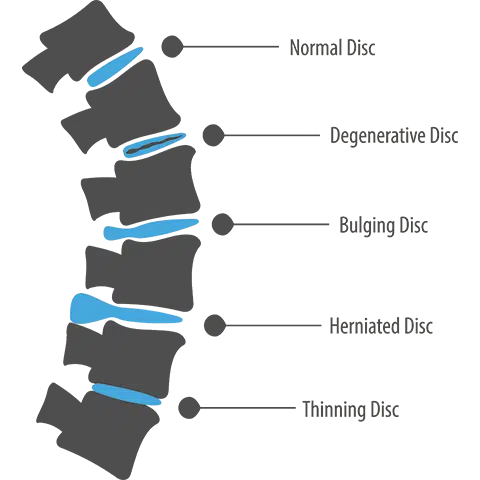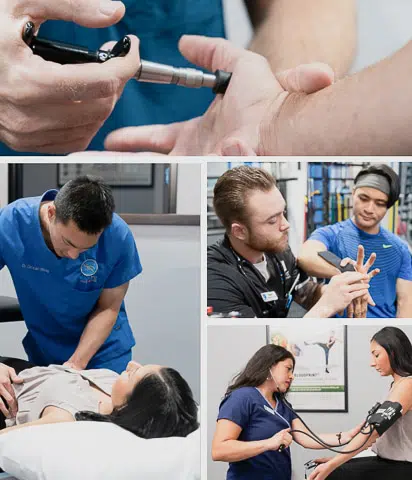Degenerative Disc Disease

Appointment Inquiries
Call us at: (877) 222-5348
Definition
Also called DDD or spinal osteoarthritis, this condition occurs naturally with age. It consists of loss of cushioning between the intervertebral discs causing pinched nerves, pain—or weakness.
Root Causes
"Pins and Needles", Hip Pain, Leg Pain, Loss of Flexibility, Loss of Height, Muscle Spasms, Numbness, Stiffness
Risk Factors
Excessive Strain, Family History, Obesity, Poor Posture, Smoking, Weak Core Muscles
Treatments
Chiropractic, Massage Therapy, Physical Therapy, Weight Loss
What is degenerative disc disease (DDD)?
Despite its name, degenerative disc disease is not a disease but a natural occurrence of age. According to the Neurological Institute of New York, by 35 years old approximately 30% of us will show evidence of disc degeneration. By the age of 60, more than 90% of us will.
Your spine is made of bone, soft tissue, and nerves. Between every bone of your spine (the vertebrae) is soft tissue, which are called the spinal or intervertebral discs. These spinal discs act as shock absorbers for your back so you can flex, bend, and twist. As we age, the discs often show signs of wear and tear. Any disc can degenerate from the cervical spine to the lumbar spine, and multiple discs can simultaneously degenerate.
Not everyone feels pain from degenerative discs, but spinal degeneration is not unlike tooth decay: it is often a painless process at first, but by the time you notice a problem or feel pain, degeneration often has already been happening for years. Degenerative disc disease is often accompanied by degenerative facet joint disease, also known as osteoarthritis of the spine.
Causes of degenerative disc disease
Other than age, there are more factors that may speed up degeneration or start it earlier in life. Repeated daily stress can hasten onset of damaged discs, but one of the major factors for earlier degenerating discs is if your spine develops fixations. Fixations are when the spine locks up, even mildly, limiting movement and function, possibly causing pain. Spinal fixation can potentially starve your discs of necessary fluid and nutrients.
Obesity, strenuous physical work, tobacco smoking, and acute or sudden injury are also major causes of hastened degenerative disc disease.
Phase 1 if degeneration
In the 1st stage of degenerative disc disease, your spine will begin to lose it’s normal curve. There may be not pain, but you may feel:
- Minor discomfort
- Less energy
- Slight loss of height
Also, once degeneration starts, it will occur more quickly because your joints, discs, nerves, and posture are each more stressed.
In phase 1, response to spinal care such as chiropractic care and spinal decompression are recommended.
Phase 2 of degeneration
In the 2nd stage of degenerative disc disease, there is clear evidence of decay, disc narrowing, and bone spurs or deformations. You may feel:
- Aches & pains
- Fatigue
- Postural changes
- Further height decrease
- Diminished ability to cope with stress
You may also develop spinal stenosis in phase 2. This is where the spinal canal narrows often pinching the nerves in the spinal cord. The symptoms of stenosis include:
- Numbness or weakness in the arms, hands, legs, or feet
- Cramping in one or both legs, which eases when you bend forward or sit
- Problems walking or with your balance
- Back or neck pain
- Bowel or bladder problems (severe cases)
With care, significant improvement within phase 2 is possible.
Phase 3 of degeneration
In the 3rd stage of degenerative disc disease, there are more postural changes, increased nerve damage, permanent spinal scar tissue, and advanced bone deformation. Physical and/or mental weakness and disability are apparent. Loss of energy and height continue.
Luckily, with care, much reversal is still possible.
Phase 4 of degeneration
In the 4th stage of degenerative disc disease, postural imbalance is severe and motion is limited. There is extreme nerve damage, scar tissues, and bones may be fused or on their way to fusing.
If you are in phase 4, you will feel:
- Pain
- Various degrees of mental or physical disability
- Loss of energy
- Loss of height
But there’s still hope. Care in this phase can offer symptomatic relief and some limited correction.
Treatment to prevent degenerative disc disease
As you probably noticed, preventing degenerative disc disease before it becomes a problem is key. Chiropractic care specifically can reduce or halt spinal degeneration. Chiropractic can also improve balance and posture.
No matter what stage of degeneration you may be in, physical therapy is also recommended. Since DDD can weaken your spine significantly, prescribed strengthening and stretching of your back, neck, and core muscles can help.When your muscles support your spine, it has to work less which may lead to reduced pain.
If you are not feeling pain, you might notice a loss in height first. The earlier degeneration is identified, the better the chance we have to arrest and reverse it. If you are considering back surgery or spinal fusion, there may be a non-invasive way that we can help.
More About BackFit
Looking to learn more? Explore our locations, treatments, or our new patient offer below or contact one of the BackFit Family of staff to have your questions answered.


